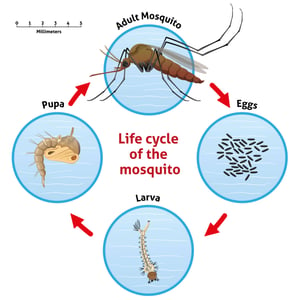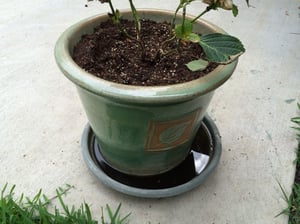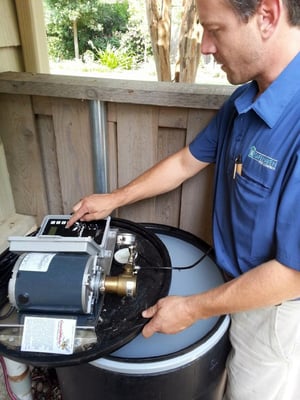Mosquito Control Treatment
The mosquito is arguably the most annoying bug of all time; its bite is irritating, its hum is annoying, and it spreads diseases such as Malaria, dengue, yellow fever, Zika Virus, West Nile Virus, etc. These bugs cause so much affliction to the human race that eliminating them would save at least one million people every year.
Although mosquitoes need to be eliminated, not all species of mosquitoes are disease vectors. There are over 3,500 mosquito species, and the percentage of disease vectors among them is quite small. It's impossible to know what would happen if all mosquitoes were to be eliminated, thus targeted mosquito control works better.
 How do you control mosquitoes?
How do you control mosquitoes?
The main goal is interrupting their life cycle.
1. Inspection
The first step to solving a pest problem is to identify the pest. This is where professional pest control services come in handy. The team will begin by interviewing you as they need to know more about the pest problem before they can take action. They will ask questions like; are the mosquitoes active at night or during the day? Do you have stagnant water, such as puddles in your yard? The idea is to gather as much information as they can to help aid the inspection.
The next step is to find the breeding ground. Mosquitoes breed in stagnant freshwater; thus, anything

that has standing freshwater is a potential breeding site. It could be anything from untended pools, tins, discarded tires to artificial containers, and clogged rain gutters.
If the mosquitoes are more active at night, they are resting during the day in brushes, uninhabited locations, weed, or tall grass.
Examine your property keenly, and you'll find all the areas where the mosquitoes breed and rest.
2. Inspect the house
If the mosquito bites occur while you're indoors, you need to find the entry points. How do the mosquitoes get into the house? Is it via broken windows, open doors, poorly fitting doors, or missing screens? Are the mosquitoes attracted to light?
3. Mosquito control
Now that you've identified the breeding sites, the resting sites, and entry points, you can proceed to implement control methods. Combating mosquito population is only possible when you combine several control methods. This approach is referred to as Integrated Pest Management (IPM).
If you eliminate the breeding sites but leave the resting sites untouched, you haven't controlled the population. They will find another breeding site and continue being a menace. However, if you were to eliminate all breeding sites, and use pesticides to kill all adults, you have a better chance of controlling the population.
- Mist Treatment- Mosquitoes are attracted to moisture, which is why they hide in tall grass during the day and breed
 in stagnant water. If you can eliminate the moisture in their hiding spot, they will die out. Using a specialized misting system, your technician will apply a mosquito repellent treatment in all resting areas. This includes sites such as shrubs, bushes, ornamental plants, roof lines, flower beds, etc. Every location that has mosquitoes should be coated with this repellent.
in stagnant water. If you can eliminate the moisture in their hiding spot, they will die out. Using a specialized misting system, your technician will apply a mosquito repellent treatment in all resting areas. This includes sites such as shrubs, bushes, ornamental plants, roof lines, flower beds, etc. Every location that has mosquitoes should be coated with this repellent.
With no moisture, the mosquitoes will soon die out, and your yard will become a dead zone as mosquitoes can't survive. However, since the mist treatment doesn't last forever, it will wear out in about 30-40 days. It will take some time before new mosquitoes encroach your yard, but it's inevitable. The only option is to keep repeating mist treatment once every month during mosquito season. This will help control the mosquito population in your yard.
- Larvae Control- Source reduction helps control the mosquito population by destroying their breeding sites. You can start by draining all stagnant water in your compound. Clean your rain gutters, empty or turn over open containers that can hold water, drain potholes, or anything that collects water every 5-7 days. Cover all your permanent water points such as wells, water tanks, cesspools, etc. Also, cover your trash cans to prevent water accumulation, which creates a breeding site.
Mow your lawn and trim any vegetation in your compound to make it inhabitable for adult mosquitoes. In case you have water collection points that you can’t drain, use larvicides to kill the larvae. Apply the larvicide directly to the stagnant by use of backpack sprayers. If the area is bigger, you can use a truck or aircraft-mounted sprayer to apply the larvicide.
Conclusion
The life cycle of a mosquito is 2 weeks, and a female mosquito can lay close to 400 eggs, which is why the mosquito population grows rapidly if it's not controlled. Use IPM to control the population and enlist the help of your neighbors. It's counterproductive to eliminate the mosquitoes on your compound only for a new scourge to migrate from your neighbors’ compound to yours. Remember that mosquito treatment will not eliminate mosquitoes completely; thus, you need to empty cans or puddles of water every 5-7 days and repeat the IPM once every month, especially during the mosquito season.




